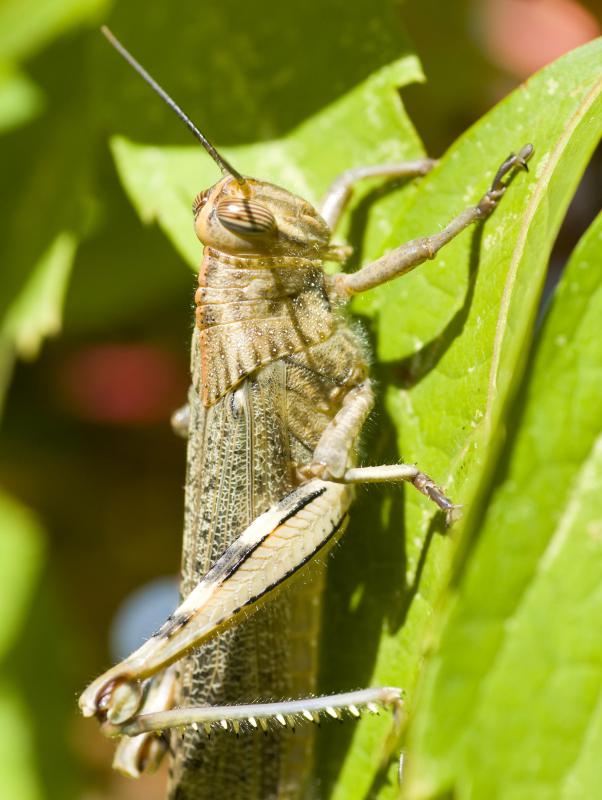At AllThingsNature, we're committed to delivering accurate, trustworthy information. Our expert-authored content is rigorously fact-checked and sourced from credible authorities. Discover how we uphold the highest standards in providing you with reliable knowledge.
What are Locusts?
Locusts are grasshoppers in the family Acrididae. Many people associate them with the Biblical plague of insects chronicled in Exodus, but modern-day locusts do a fair amount of damage as well. Fortunately for farmers, they will only swarm under certain conditions, and many of these insects live out peaceful, calm lives with no similarities to their infamous Biblical ancestors.
Like other grasshoppers, locusts have powerful hind legs that are designed for jumping. They are also capable of producing musical sounds with their wings and hind legs, and they have distinctive short antennae. This last trait has led some people to call locusts “short horned grasshoppers.” When the insect lays eggs, it buries them in the ground; as the eggs hatch, a larval form called a nymph emerges. Nymphs slowly mature into adults to repeat the cycle of reproduction.

Under most circumstances, locusts live out relatively solitary lives, questing for food, laying eggs, and then quietly dying. However, when locusts are subjected to overcrowding as nymphs, they develop into gregarious migratory adults. This evolutionary response was probably designed to ensure that the young had a chance at survival by encouraging them to venture far afield, but groups of these insects have been having a devastating effect on human crops for thousands of years.

When locusts swarm, they can eat their own body weight in food every day. They gather in huge groups that can literally darken the sky and strip fields bare. There is little to be done when combating a modern-day plague of locusts; many farmers burn green branches to create smoke in the hopes of driving the insects out, but this technique is not always effective. Predatory species are sometimes used to control locusts, along with chemical solutions like insecticides, but none of these methods are foolproof. In an astoundingly short period of time, they can completely destroy a crop; irritating for commercial agriculture, but life-threatening for subsistence farmers.
These interesting grasshoppers have been a frequent subject of study for biologists and scientists. Their unusual swarming behavior has been extensively studied in the hopes of understanding and perhaps preventing devastating swarms. One of the most infamous is the desert locust, Schistocerca gregaria, which plagues much of Africa, Asia, and the Middle East in huge swarms that can travel over immense distances, causing severe damage.
Frequently Asked Questions
What exactly are locusts?
Locusts are a type of short-horned grasshoppers belonging to the family Acrididae. They are notorious for their swarming behavior, which is a phase change from their solitary lifestyle. When environmental conditions are favorable, such as after a period of drought followed by rapid vegetation growth, locusts can form vast swarms that travel long distances and devastate crops.
How do locust swarms form?
Locust swarms form when there is a significant increase in population density, triggered by factors like abundant rainfall and subsequent vegetation growth. This leads to increased tactile stimulation of the hind legs, causing locusts to switch from a solitary to a gregarious phase. In this social state, they become more mobile and start to form bands as nymphs and swarms as adults, often leading to large-scale agricultural damage.
What is the difference between locusts and grasshoppers?
While locusts are a type of grasshopper, the key difference lies in their behavior. Grasshoppers typically lead solitary lives and do not change behavior based on population density. Locusts, on the other hand, can undergo a dramatic transformation under certain environmental conditions, changing color, behavior, and forming large swarms that migrate over vast distances, a phenomenon not observed in regular grasshoppers.
How far can locust swarms travel?
Locust swarms can travel impressive distances, covering up to 150 kilometers (about 93 miles) in a single day. They are driven by the wind and can migrate across continents, with the Desert Locust being the most well-known for its extensive travel. Swarms can cross seas and traverse vast areas, causing widespread agricultural devastation in their wake.
What kind of damage can locust swarms cause?
Locust swarms can cause catastrophic damage to agriculture, capable of stripping fields bare in a matter of hours. According to the Food and Agriculture Organization (FAO), a small swarm covering one square kilometer can eat the same amount of food in one day as 35,000 people. This can lead to food shortages, economic loss, and famine in affected regions.
Are there any effective methods to control locust swarms?
Controlling locust swarms is challenging but possible. Methods include monitoring and early warning systems to detect swarm formations, followed by targeted pesticide application to control the population. Biological control using pathogens and predators, as well as barrier and deterrent methods, are also being explored. However, the vast scale of swarms often requires international cooperation for effective management.
AS FEATURED ON:
AS FEATURED ON:












Discussion Comments
yes i go biking every day and there are bushels of corns next to the bike path. one day i was biking past and they swarmed all over me so i biked the heck out ofa there.
anon14192 - Typically locust don't bite humans. They're just grasshoppers in their swarming phase and grasshoppers don't bite. Locusts also include cicada, which also can swarm, but also don't bite. Finally, sometimes locusts refer to the praying mantis, also called the praying locust, and these bite. But most commonly, the word locust refers to the grasshopper kind and these don't bite.
Will locusts bite humans?
Post your comments